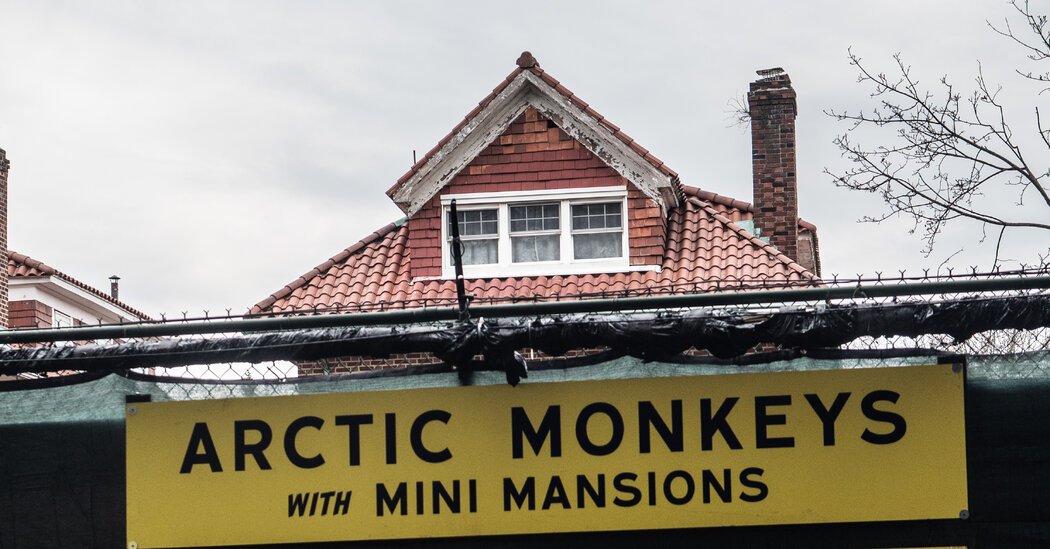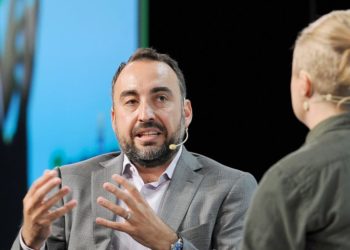When Frederick Law Olmsted Jr. designed Forest Hills Gardens, he was trying to bring the respite of an English village into the bustle of New York City.
A landscape architect and city planner like his father, one of Central Park’s designers, Mr. Olmsted laid out tree-lined alphabetical streets and open spaces in a pocket of Queens about nine miles east of Times Square. In 1909, these were not mere aesthetic choices: Forest Hills Gardens was an import of the English garden city, a turn-of-the-century movement in urban planning rooted in a utopian ethic.
Mr. Olmsted planned for the Tudor-style houses to thoughtfully integrate with their manicured landscapes, for winding pathways to promote leisurely strolls and for curved residential streets to discourage vehicles from passing through.
He did not plan, however, for the Australian rock band King Gizzard and the Lizard Wizard. Or for the sold-out shows by the Irish singer Hozier. Or really for anything about the concert venue that was once a storied tennis stadium and is now rattling both windows and nerves in the neighborhood.
“It does disrupt the calm,” Mitch Palminteri, a Forest Hills Gardens resident, said at a recent community board meeting. “I don’t want to close my window on a summer night.”
Others like what the concerts represent.
“Music is about community,” said Joseph Cooney, who lives in adjacent Forest Hills. “We have it in spades in this neighborhood. How can we ever let that go away?”
What a 21st-century Forest Hills Gardens should be — A quiet haven? Or an occasional thumping concert venue that draws thousands of visitors? — and who gets to decide has turned neighbors into foes. Thousands have signed competing online petitions. Not long ago, when I was interviewing the main concert promoter, a passer-by interrupted to proclaim, “Everything out of his mouth is a lie.”
At stake is a popular concert season that provides entertainment and lifts the local economy, but also frustrates some residents who say the shows flout the city’s noise code and pierce the sanctity of their summers.
The feud, lingering for well over a decade, has grown more intense in recent months. A lawsuit by nearby homeowners failed to stop the concerts, so they came up with a novel legal strategy involving the New York Police Department. The bitter accusations being made include NIMBYism, corporate greed, bullying and too much electronic dance music.
The Sound and the Fury
Forest Hills Stadium hosted Jimi Hendrix, Bob Dylan and Diana Ross in the 1960s, and it is where the Beatles opened their 1964 U.S. tour after arriving by helicopter. But the concrete behemoth that opened in 1923 was not built to accommodate touring acts and music festivals. It was America’s answer to Wimbledon.
For decades the stadium hosted the U.S. national tennis championships, which became known as the U.S. Open when the tournament started welcoming professional athletes in 1968. Arthur Ashe and Althea Gibson broke color barriers there. Rod Laver twice completed a Grand Slam — winning all four of the sport’s major tournaments in one year — on its courts.
Concerts continued after the U.S. Open moved to a grander site in Flushing in 1978, including stops in the 1980s from Talking Heads and Barry Manilow. But they slowed by the late 1990s, culminating with a daylong reggae concert in 1999 that resulted in noise and parking violations. The stadium grounds were quiet for a time beyond a colony of feral cats.
Eventually, the promoter Mike Luba, a veteran of the jam band scene, had the idea of bringing music back to Forest Hills Stadium. The concerts resumed in 2013 with a performance by the folk rock band Mumford & Sons and have become a thriving business with a diverse lineup. Among the 37 shows last year were Kings of Leon, Tiësto and Pitbull.
Residents of the Gardens and nearby Forest Hills who enjoy the concerts said they loved being able to walk home from the stadium, or even just sit in their yards with a cooler while enjoying the music for free.
Doug Gilbert, who moved to the Gardens with his wife 30 years ago, would prefer the quiet. His beautiful lived-in Tudor, where light streams in through a multicolored diamond-paned glass window, is part of a small stretch of houses on Dartmouth Street with the stadium grounds in their backyards.
“When the concerts exceed the noise limit and the windows vibrate, you just can’t do anything,” Mr. Gilbert said.
He has data to prove it: An acoustic engineer took sound readings in Gardens homes, including Mr. Gilbert’s, and found that 11 of the 13 measured concerts violated the municipal noise code.
And decibel readings do not account for bass frequencies, so there is no record of the rumbling vibrations of electronic dance music, only neighbors’ frustration with it. Mr. Gilbert said half the lightbulbs in his chandelier have shut off during a show after being jiggled loose. (The only show he has seen inside the stadium is the New York Pops.)
That’s not the half of it. The discordant riffs of sound checks start early, and even though the music has to end by 10 p.m., the trucks carrying equipment sometimes do not leave until after midnight. There is no dedicated location for Uber or Lyft, meaning that passengers roam the streets in search of pickup points. Trash is ditched in the grass, and some of the concerts are scheduled on religious holidays and school nights.
Then there is the urine.
“I don’t have a problem with the concert,” Sean Baker, who lives 250 feet from the stadium, told the community board. “I have a problem with the fact that there’s not a single toilet provided for the people in line, so they go into our backyards and use our yards for their toilet.”
The team behind the stadium says there is more to the story.
‘EDM Is What the Beatles Were’
Whipping wind and the hammering sounds of construction rang in the background as Mr. Luba, the head of the company that runs Forest Hills Stadium, showed me its bass traps.
The metal meshed-in corridors are designed to dampen bass frequencies and concert music. Walking through them as you ascend the stadium’s stairs toward 13,000 seats is a bizarre experience, like someone is muffling your hearing with their hands.
“We had to put up the signs,” Mr. Luba said. “People were freaking out. They’re like, ‘Something’s wrong with my ears.’”
The stadium received 20 citations from New York City between 2022 and 2024, most for noise violations and some for going past the curfew, said a spokeswoman for Mr. Luba’s company, Tiebreaker Productions. It has paid the fines while appealing some of them.
The spokeswoman said the stadium had no issues complying with the 75-decibel limit — about the equivalent of a vacuum cleaner or a barking dog — on the sound permits it received from the Police Department. But in 2023, the city also started to measure the concerts against a 45-decibel standard meant for noise from stores, bars and restaurants.
In response to the noise complaints, Mr. Luba said, the stadium is reducing the size of its speakers and incorporating more of them.
But he said efforts to install portable toilets and trash cans have been blocked by the Forest Hills Gardens Corporation, a homeowners’ association; Mr. Luba says it wanted a visible problem to rally behind, a contention the association said was part of a smear campaign to make the Gardens the villain.
Mr. Luba disagrees with the noise code itself, saying that every Long Island Rail Road train that goes by the stadium breaks the municipal standards. He also questioned the veracity of complaints about EDM shows by artists like Sofi Tukker and Dom Dolla. As evidence, he produced a video of a cup of water — not frozen, he promised — whose surface was undisturbed by a recent concert.
“There was no EDM in 1960 or 1970,” he said. “EDM is what the Beatles were when the parents that didn’t want the Beatles were here. I’m not interested in culturally gatekeeping what people want to see.”
Mr. Luba once managed the jam band String Cheese Incident and has worked for the large entertainment companies Live Nation and AEG. So when he had the idea of bringing concerts back to Forest Hills Stadium, he understood the risks. He even told one of his business partners to put $2 million in a suitcase and burn it to see how it felt.
“If you can do that, you can be in the music business with me,” he said.
The first concert Mr. Luba oversaw at the stadium, by Mumford & Sons, did not go smoothly: Complaints included “disgusting and miserable” conditions and the assertion that the frontman Marcus Mumford did not look as cute as usual. Mr. Luba said he gave back “every single penny” to the concertgoers who requested a refund.
Tiebreaker made changes that worked, and Forest Hills Stadium’s concert season now runs from May to October, bringing in fans from New York’s five boroughs and beyond. When there were about a dozen shows a year, the neighbors were relatively content. But as the frequency of the concerts has increased, so have the complaints.
Mr. Luba maintained that he needed to schedule at least 30 shows a year for the endeavor to make financial sense. “Our only way to pay for the stupid lawsuit is to add more shows,” he said.
In a tour of the stadium, its tennis history is evident. Mr. Luba pointed out a framed photo of a teenage John McEnroe and a professional tennis player playing doubles against Santana and Meat Loaf. Of the touring musicians who have played at the tennis club, Mr. Luba said the British producer Fred again.. and the new wave band Tears for Fears stood out most.
But, he said, the conflict with the neighbors has taken some of the fun out of his work.
“It was a vision quest, like a passion project,” he said. “And now this has become this whole ordeal.”
A Cultural Conflict
When you cross beneath the railroad overpass that divides Forest Hills from Forest Hills Gardens, tightly packed businesses give way to airy roads and the sidewalks turn from standard New York cement to a scrubbed pebble finish.
In the planned neighborhood, the roadways are owned by the Forest Hills Gardens Corporation. And this year, after growing frustration among some residents, the association announced it would bar access to the New York police officers who traditionally provide security for the long lines that form outside the stadium before concerts. (Police officers and ambulances are allowed to respond to emergencies.)
The Police Department’s legal bureau affirmed in a letter that the association had that authority, and that if the department could not ensure public safety at the venue, it would not issue the sound permits needed for the concerts to proceed.
That raised fears that this year’s shows — including Phish, Alabama Shakes and, yes, King Gizzard and the Lizard Wizard — could be delayed or canceled. The timing left only weeks for the sides to reach détente before Bloc Party and Blonde Redhead were supposed to open the season on May 31.
Not all of the neighbors have issues with the concerts. Stickers in the windows of several small businesses in the area offer their support. The West Side Tennis Club, which leases the stadium to Tiebreaker and agreed to host the concerts to subsidize tennis, said in a recent newsletter that the effort to shut down the concerts was “draconian.”
Jillian Grancaric, who lives in Tennis View Apartments, used to be the building’s liaison with the stadium and still manages the complimentary tickets for residents. She said there were plenty of takers among the 144 units and that she had had only positive experiences with the stadium.
“I feel that all the right things have been done, and it’s just a bunch of grumpy people,” she said.
During the public comment session at Queens Borough Hall this month, 31 people spoke in support of the stadium — or, in one case, sang and played acoustic guitar — while nine spoke against. Eleven people wrote letters against the concerts, with one in support.
Matt Mandell, a Gardens resident along with his wife, Sandra, helped broker an uneasy peace while he was president of the homeowners’ association but said in an interview that the increase in shows had pushed the group to the breaking point.
“There’s a lot of people making this story complicated,” said Mr. Mandell, who now serves as the group’s legal chair. “But it’s really about violating the law.”
Andy Court, the president of Concerned Citizens of Forest Hills, agreed, saying that his group of homeowners and renters simply wanted respect for the neighborhood’s regulations. Although they have been called complaining NIMBYs, an acronym for those who say “not in my backyard,” he said it is the other side that is being unreasonable.
“I think there’s cultural conflict here: It’s between people who think you should work things out with your neighbors and follow the rules of the city you live in, and people who think they’re so powerful and so cool, they can just do whatever they want,” Mr. Court said.
Despite the letter from the Police Department’s legal bureau, Mr. Luba remained optimistic that an agreement would be reached, and reassured touring acts it would be business as usual this summer.
His faith was rewarded this week when the stadium announced it had reached a deal with the Police Department. The stadium will hire private security to monitor the streets outside, and the police will grant the sound permit for the season-opening concert on May 31.
Mr. Luba is confident all the permits needed this year will eventually come through. But Mr. Mandell said the homeowners’ association did not think the stadium had the authority to use private security on its streets.
“They went behind our backs,” he said. “In doing so, they prevented meaningful long-term resolution.”
For now, it looks like the shows will go on.
When the band Crumb posted on social media about its scheduled performance on June 21, it included a “Where’s Waldo?”-style illustration of the stadium that asked fans to help the musicians find their instruments.
The detailed backdrop features the Long Island Rail Road and Tudor-style architecture, showing frog and duck onlookers leaning out of apartment windows to gaze happily at the stadium. The illustration’s only human character is so small he could be easily missed.
In the top window of the apartment building, a lone face scowls.
Annie Aguiar is a reporter covering arts and culture and a member of the 2024-25 Times Fellowship class, a program for journalists early in their careers.
Graham Dickie is a Times photographer and a member of the 2024-2025 Times Fellowship class, a program for journalists early in their careers.
The post The Concert Cold War in a Quiet Enclave appeared first on New York Times.




